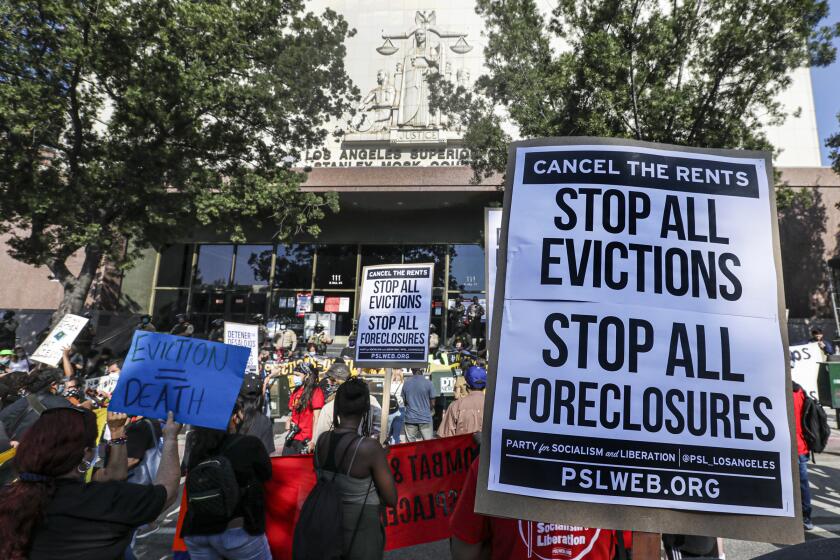Opinion: The mass evictions at Barrington Plaza will happen again if L.A. doesn’t act to protect renters

- Share via
Last week, corporate landlord Douglas Emmett Inc., announced plans to evict all tenants in its 25-story Barrington Plaza apartment complex in West Los Angeles. The building comprises 712 rent-stabilized units, 577 of which are occupied by residents. The company, which owns 18.3 million square feet of office space and 4,209 rental units in Los Angeles and Honolulu, has cited a city order to upgrade the building’s sprinkler system as the reason for these evictions, which came after a 2020 fire injured 13 and killed one resident.
The Los Angeles Housing Department’s decision to allow these evictions is unusual, and it sets a dangerous precedent as Los Angeles gears up to mandate extensive renovations to residential buildings as part of its Green New Deal decarbonization efforts.
Douglas Emmett is using the Ellis Act, which drives Californians into homelessness, as the justification for the mass eviction. Passed in 1985, this California state law was created to allow mom-and-pop landlords who are planning to “go out of business” to evict tenants from rent-controlled units to take them off the rental market. But the Ellis Act has been routinely used by corporate landlords to circumvent local eviction protections in order to oust low-income renters and transform their homes into boutique hotels and pseudo-condominiums. This has led to the removal of tens of thousands of rent-controlled units in Los Angeles, exacerbating the city’s affordable housing crisis and displacing working-class communities.
Tenants of Barrington Plaza, a high-rise L.A. apartment complex, will be evicted to make way for the addition of fire safety sprinklers
According to Los Angeles’ Rent Stabilization Ordinance, landlords may evict tenants from rent-controlled units if there is an “order to comply with a governmental agency’s order to vacate, order to comply, order to abate, or any other order that necessitates the vacating of the building housing the rental unit.” In this case, such an order exists, and for good reason — the building’s poor fire safety system has been a danger to tenants for decades.
Douglas Emmett’s position that this order “necessitates” eviction, and not temporary relocation for tenants, is a typical maneuver to raise rents by vacating rent-stabilized units. But why is the city of Los Angeles bending over backward to help a $2-billion corporation sidestep anti-eviction laws? Douglas Emmett has already admitted that it has no intention of removing Barrington Plaza from the rental market when the renovations are complete, as the Ellis Act requires. Nor is Los Angeles using its mechanism to protect rent-stabilized tenants from harm or displacement due to city-mandated building renovations.
The Tenant Habitability Program (THP) assesses the effects of large-scale renovation work and helps mitigate disruption and displacement through temporary housing, financial assistance and the adoption of work procedures that allow tenants to remain in their units. Structural repairs for fire safety are among the program’s qualifying scope of work.
Unfortunately, Barrington Plaza is not the first mass Ellis Act eviction in Los Angeles, and it won’t be the last. But it should serve as an urgent reminder that we must have strong tenant protections in place as the city begins legislating decarbonization for residential buildings.
Last April, the Los Angeles City Council voted to establish a plan to reduce the carbon footprint of tens of thousands of buildings citywide by retrofitting them with emissions-reducing and energy-saving technologies, as part of the Los Angeles Green New Deal to reduce carbon emissions by 2050. Under the plan, residential property owners will eventually be required to retrofit their buildings to reduce their carbon footprint, which could include electrical panel upgrades, disconnection from natural gas and new appliances. These retrofits can easily total tens of thousands of dollars per unit, with much of the costs due up front.
The anti-harassment ordinance is aimed at stopping the worst violations by property owners, who flagrantly break the laws that honest landlords follow.
The city must do everything in its power to ensure that these costs aren’t borne by tenants. Two million people rent in Los Angeles, and a 2019 USC study found that more than 70% of households are severely rent-burdened. Los Angeles also has a scarcity of affordable housing. If the city allows mandatory retrofits to be funded by rent increases or used as an excuse to evict tenants, we will have an even greater reduction of affordable units and see more of our neighbors destabilized by displacement, debt and homelessness.
California lawmakers should repeal the Ellis Act. In the meantime, the city must use its existing powers to protect our renter population, including upholding the Tenant Habitability Program wherever it applies and narrowly limiting the types of government orders that can trigger a no-fault eviction. It should also create and implement a public subsidy program for small landlords who keep units affordable. In fact, we already do this for homeowners: State and federal subsidy programs exist for improvements such as adding residential solar power, low-flow toilets and showerheads, and energy-efficient windows. Subsidies for property owners should be means-tested so that the public is not footing the bill for corporate landlords and investors.
We urgently need environmental measures that keep communities healthy, but not at the cost of displacing tenants from their homes. Decarbonization efforts must be developed with strong tenant protections, including restrictions on evictions and rent increases. Otherwise, we just are replacing one set of problems with another.
Chelsea Kirk is the director of policy and research for Building Equity and Transit at Strategic Actions for a Just Economy.
More to Read
A cure for the common opinion
Get thought-provoking perspectives with our weekly newsletter.
You may occasionally receive promotional content from the Los Angeles Times.












